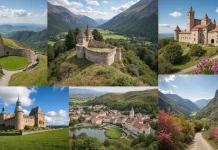The Allure of Europe’s Street Markets
Europe’s street markets offer a captivating glimpse into the heart of its cities and towns. These bustling markets are more than just places of commerce; they are sites of culture, history, and community life. From food to crafts and antiques, European street markets provide endless opportunities for exploration and discovery. Their vibrant atmosphere is irresistible, offering locals and tourists alike an authentic taste of regional life.
Discovering Culinary Delights
Street markets in Europe are gastronomic havens, providing an array of culinary delights that reflect local traditions and contemporary innovations.
Paris, France: Marché Bastille
Paris, known worldwide for its gastronomic excellence, is home to numerous street markets, with Marché Bastille being one of the most prominent. Located in the heart of the city, this market offers a delicious selection of local cheeses, fresh vegetables, fragrant pastries, and succulent meats. Here, you can sample a perfectly ripe Brie de Meaux or indulge in a freshly baked croissant. Strolling through the market, sounds of French chatter fill the air, along with irresistible aromas of roasting chicken and baking bread.
Florence, Italy: Mercato Centrale
In Florence, the Mercato Centrale is a testament to Italy's rich culinary tradition. The ground floor features fresh produce stands, butchers, fishmongers, and cheese vendors, while the upper floor hosts a food court with vendors offering everything from thin-crust pizzas to creamy leather of Tuscan risotto. It is a perfect spot to savor authentic Italian flavors while mingling with friendly locals.
Barcelona, Spain: Mercat de Sant Josep de la Boqueria
One cannot discuss European food markets without mentioning Barcelona’s famous Mercat de Sant Josep de la Boqueria. Located on La Rambla, one of the busiest avenues in the city, this market is a feast for all senses. Colorful fruits and vegetables are artistically displayed, while Spanish cured meats, seafood, and cheeses offer abundant tasting opportunities. The market is a gathering place for cooks seeking high-quality ingredients and food lovers eager for authentic Spanish tapas.
Embracing Unique Crafts and Handmade Goods
Beyond food, European street markets are renowned for offering unique handmade goods and crafts. These markets are ideal for finding one-of-a-kind items and learning about the artisan techniques behind them.
Istanbul, Turkey: Grand Bazaar
In Istanbul, the Grand Bazaar is a labyrinthine complex of stalls that feels like stepping into a different era. With over 4,000 shops, it's famous for its dazzling array of carpets, ceramics, jewelry, and textiles. The skill of Turkish artisans is evident in the intricate patterns of hand-woven rugs and detailed craftsmanship of gold jewelry. Visitors can practice their bargaining skills and take home a piece of Turkish culture.
Porto, Portugal: Porto Belo Market
In Porto, the Porto Belo Market is a weekend staple, offering a carefully curated selection of antique goods, vintage clothing, and local art. It's a haven for those searching for unique collectibles, like classic vinyl records or handmade artifacts. Nestled in the city's vibrant streets, it provides a relaxed shopping experience, with musicians and artists part of the lively scene.
Berlin, Germany: Mauerpark Flea Market
Berlin's Mauerpark Flea Market offers an alternative vibe, embodying the city’s eclectic spirit. Visitors can uncover vintage threads, retro furniture, and handmade crafts, all reflecting the city's creative energy. Street performers and live music enhance the festive atmosphere, making it more than just a shopping venue–it's a place to experience the city’s unique cultural pulse.
Exploring the Rich Historical Background
Many of Europe's street markets have historical roots, with some existing for centuries. These markets are windows into a region's past, reflecting centuries-old trade practices and cultural exchanges.
London, England: Borough Market
The Borough Market in London traces its origins back to at least the 13th century. Its longevity is a testament to its significance in the city's life, evolving over centuries while maintaining its charm. Today, it offers a variety of fresh produce, artisan cheeses, cured meats, and international foods, all housed in historic buildings that echo its mercantile past.
Valletta, Malta: Il-Monti Market
Valletta's Il-Monti Market is a prized tradition, evolving over time in the historical backdrop of Malta’s capital. Known for selling an assortment of goods, from clothing to local crafts, its history is deeply entwined with the city's development. The market square itself is a convergence of Valletta’s historical architecture and vibrant contemporary life.
Vienna, Austria: Naschmarkt
Naschmarkt in Vienna, with its origins in the 16th century, is a confluence of food and historical lineage. It offers a unique blend of traditional Viennese flavor and international cuisines, set against the backdrop of beautiful, antique buildings. Exploring Naschmarkt is akin to wandering through Vienna's culinary and cultural history.
Experiencing Local Culture and Traditions
Markets play a critical role in cultural identification and are often centers of local festivities, showcasing traditions and a shared cultural bond.
Marrakech, Morocco: Jemaa el-Fnaa
The Jemaa el-Fnaa market in Marrakech is legendary for its vibrant energy and vivid display of Moroccan culture. As day turns to night, the market transforms into a festival of music, dance, and cuisine. Amid the maze of stalls, visitors can encounter storytellers, fortune tellers, and local musicians, embodying the cultural fabric of Morocco.
Copenhagen, Denmark: Torvehallerne
Copenhagen's Torvehallerne is a modern take on the traditional street market, focusing on high-quality local produce and gourmet food. It’s a lively gathering place embodying Danish “hygge” culture. Whether sampling smørrebrød (open-faced sandwiches) or craft beers, you're enveloped in a warm, convivial atmosphere.
Brussels, Belgium: Jeu de Balle Market
Brussels' Jeu de Balle Market, located in the heart of the Marolles district, offers insight into Belgian daily life. Known for its eclectic range of antiques and collectibles, it is a common ground for locals, offering a lively mix of French, Dutch, and Flemish influences. The market operates under a friendly, informal atmosphere, encouraging social interactions over good finds.
Tips for Navigating European Street Markets
Navigating Europe's street markets can be an enjoyable yet overwhelming experience due to their size and the sheer variety of offerings. Here are some tips to enhance your market adventures.
Go Early for the Best Picks
Arrive early to experience the market come to life and get first picks of the best produce or unique items. Early mornings also typically mean fewer crowds, providing a more leisurely shopping experience.
Embrace Spontaneity
Plan your must-see stalls, but also allow for spontaneity. The charm of European markets often lies in the unexpected discoveries. Wander without a set destination, and you may stumble upon hidden gems or unique cultural experiences.
Engage with Vendors
Engage with local vendors, as they are often knowledgeable about their offerings and can provide insider tips on the best local delicacies or unique products. These interactions can enrich your understanding of the local culture and history.
Cash is King
While credit cards are widely accepted in larger cities, many smaller vendors still prefer cash. Bring plenty of local currency in small denominations to facilitate easier transactions, and be prepared to haggle in markets where bargaining is customary.
Indulge in Street Food
Street food is an essential part of the market experience. Try local specialties for both culinary enjoyment and cultural immersion. Sampling street food is not only delicious but an economical way to discover the flavors of a region.
The Sustainable Side of Market Shopping
Beyond the sensory experiences, European street markets promote sustainable shopping practices, fostering a more eco-friendly approach to consumption.
Reducing Food Miles
By shopping at local markets, you support producers who offer hyper-local produce, often grown or made within the surrounding areas. This reduces transportation emissions and supports sustainable agricultural practices.
Supporting Small Businesses
Purchasing from market vendors typically translates to supporting small, independent businesses, bolstering the local economy. Many vendors practice sustainable production methods, from organic farming to ethically made goods.
Eco-Friendly Shopping Practices
Markets tend to encourage the use of reusable bags and packaging, helping reduce plastic waste. Some vendors offer return policies for containers, promoting a circular economy and encouraging consumers to bring their own shopping bags.
A Journey Through Time and Culture
Visiting Europe's street markets is not just a shopping trip, but a journey through time and culture. Whether buying fresh produce in a centuries-old market or exploring the eclectic offerings of a modern-day flea market, these spaces provide authentic snapshots of life in each locale.
Beyond commerce, markets are places for storytelling and connection, where generations pass on traditions and new stories are written daily through simple interactions. As you discover Europe's vibrant street markets, you join a centuries-old tradition, becoming part of the ever-evolving tapestry that is Europe’s market culture.






























